
Facts About Alzheimer’s Disease and Its Impacts: 50 Eye-Opening Statistics

Basic Facts About Alzheimer’s
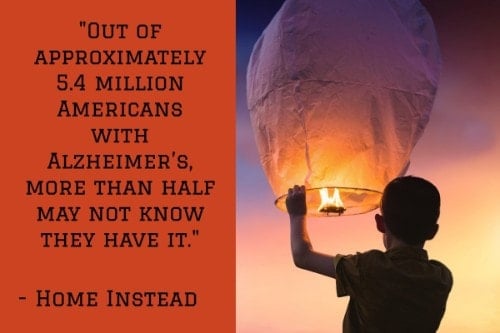
- More than half of all people with Alzheimer’s disease are unaware that they have it. “Out of approximately 5.4 million Americans with Alzheimer’s, more than half may not know they have it. In part because of the difficulty with detecting early-stage Alzheimer’s or mild cognitive impairment (MCI), many of those with Alzheimer’s remain undiagnosed.” – 8 Interesting Facts About Alzheimer’s, Home Instead; Twitter: @HISCLynchburg
- Alzheimer’s disease was discovered in 1906. “The disease is named after Dr. Alois Alzheimer. In 1906, the neuropathologist did an autopsy on the brain of a woman who died after exhibiting language problems, unpredictable behavior and memory loss. Dr. Alzheimer discovered the amyloid plaques and neurofibrillary tangles, which are considered the hallmarks of the disease.” – Alzheimer’s Disease Fast Facts, CNN Health; Twitter: @cnnhealth
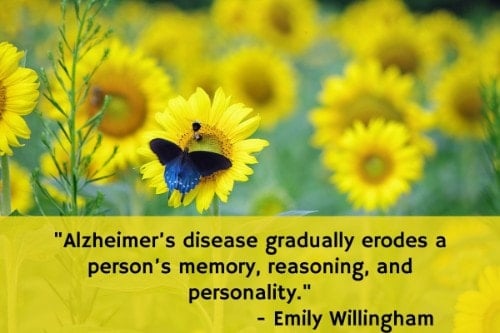
- The risk of developing Alzheimer’s disease increases with age. “Alzheimer’s disease gradually erodes a person’s memory, reasoning, and personality. It is a disease of old age, primarily affecting those over 65. For people who live to be 85 or older, the likelihood of developing this progressive degenerative disorder reaches one in two.” – Emily Willingham, 10 Essential Facts About Alzheimer’s Disease, Everyday Health; Twitter: @EverydayHealth
- Alzheimer’s disease can affect younger people, too. “An estimated 5.7 million Americans of all ages are living with Alzheimer’s dementia in 2018. This number includes an estimated 5.5 million people age 65 and older and approximately 200,000 individuals under age 65 who have younger-onset Alzheimer’s.” – Facts and Figures, Alzheimer’s Association; Twitter: @alzassociation
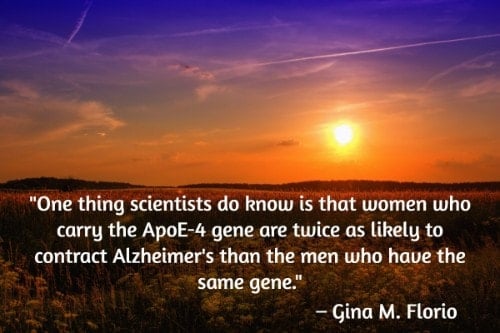
- Women comprise three out of every five people diagnosed with Alzheimer’s disease. “As if we don’t have enough health issues to worry about, three out of every five Americans living with Alzheimer’s are women, and females over the age of 60 are twice as likely to be diagnosed with this disease than breast cancer.” But why?
“Maria Carrillo, chief science officer for the Alzheimer’s Association, told the Huffington Post that there are plenty of ‘biological questions pointing to increased risk in women.” She said there’s no doubt that the issue needs to be explored more by science. It’s hard to know where to start looking, though, as there are so many relevant factors, including the fact that women simply live longer. “One thing scientists do know is that women who carry the ApoE-4 gene are twice as likely to contract Alzheimer’s than the men who have the same gene. Stanford University conducted a study proving this, but the reasons are unknown. It could be due to how ApoE-4 reacts when in tandem with large amounts of estrogen.” – Gina M. Florio, 7 Facts About Alzheimer’s Disease Every Woman Should Know, Bustle; Twitter: @Bustle
- The gender difference in Alzheimer’s prevalence is complex. “The link between differences in sex biology and Alzheimer’s is complex, and likely a product of the interplay between the aging of systems responsible for hormone delivery in the body, hormonal changes over time, and genetic risk for the disease. For example, both human and animal studies suggest that aging-related declines in estrogen, progesterone, testosterone, and other hormones leave brain cells vulnerable to toxic threats, including those from Alzheimer’s.” – Roberta Diaz Brinton, Gender gap in Alzheimer’s disease rates, caregiving needs more attention, STAT; Twitter: @statnews
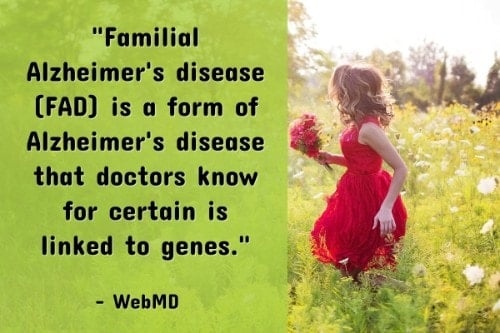
- Scientists have identified a form of Alzheimer’s disease definitively linked to genetics. “Familial Alzheimer’s disease(FAD) is a form of Alzheimer’s disease that doctors know for certain is linked to genes. In families that are affected, members of at least two generations have had the disease. FAD makes up less than 1% of all cases of Alzheimer’s. Most people who have early onset Alzheimer‘s have FAD.” – Types of Alzheimer’s Disease, WebMD (WebMD Medical Reference Reviewed by Neil Lava, MD); Twitter: @WebMD
- While genetics isn’t a definitive predictor of Alzheimer’s disease, scientists have discovered a link between the ages of parents and children related to the onset of the disease. “Much is being discovered about the genetic origins of Alzheimer’s disease, but it is still considered to be caused by a combination of genetic and environmental factors, and generally not a primarily heritable condition. A new study is suggesting the genetic impact of the disease could be more significant than previously thought, finding a strong link between the ages of parents and children for the onset of the disease.”
“The study, led by Sylvia Villeneuve from McGill University, found that the closer a person gets to the age their parent displayed the first signs of Alzheimer’s disease, the more likely they were to have a build-up of amyloid plaques in their brain.” – Rich Haridy, Family history found to impact onset age of Alzheimer’s disease, New Atlas; Twitter: @nwtls 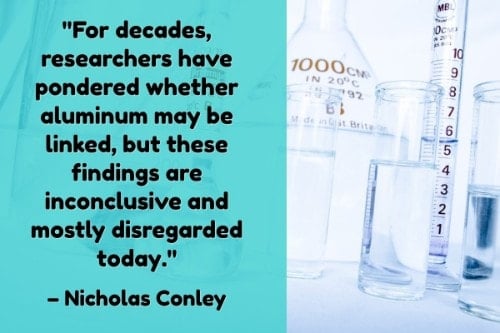
- No definitive cause has been identified for other types Alzheimer’s disease. “Some studies have shown evidence that poor sleeping habits may cause plaques to form, but it’s unclear whether sleep deprivation causes Alzheimer’s or is simply a side effect of it. For decades, researchers have pondered whether aluminum may be linked, but these findings are inconclusive and mostly disregarded today. Just recently, obesity during midlife—and the health problems that arise from the standard obese lifestyle—were potentially linked to an earlier onset of Alzheimer’s. And of course, there is always genetics.”
“Many researchers are hard at work on isolating the cause and finding a cure, so we can only hope that someday soon, we will know more surely.” – Nicholas Conley, 10 Surprising Facts About Alzheimer’s, HeadStuff; Twitter: @ThisHeadStuff
- The prevalence of Alzheimer’s disease is growing rapidly. “The number of Americans with Alzheimer’s disease and other dementias will grow each year as the size and proportion of the U.S. population age 65 and older continue to increase. By 2025, the number of people age 65 and older with Alzheimer’s disease is estimated to reach 7.1 million — a 40 percent increase from the 5.1 million age 65 and older affected in 2015. By 2050, the number of people age 65 and older with Alzheimer’s disease may nearly triple, from 5.1 million to a projected 13.8 million, barring the development of medical breakthroughs to prevent or cure the disease.” – Facts and Stats, Alzheimer’s Orange County; Twitter: @OCAlzheimers
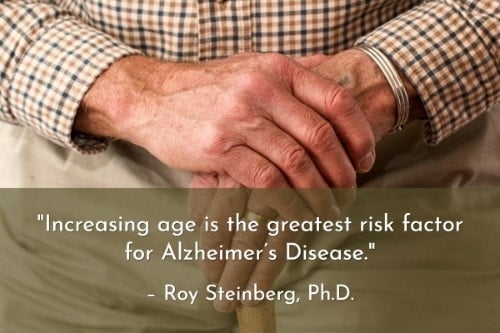
- Increasing age is the greatest risk factor for Alzheimer’s disease. “Increasing age is the greatest risk factor for Alzheimer’s Disease. One in 10 individuals over 65 and nearly half of those over 85 are affected. Rare, inherited forms of Alzheimer’s Disease can strike individuals as early as their 30’s and 40’s.” – Roy Steinberg, Ph.D., Alzheimer’s Disease Facts, Caregiving for Caregivers
- There is no test that can definitively predict late-onset Alzheimer’s. “There is no test yet to predict if someone will get late-onset Alzheimer’s, in which symptoms become apparent in a person’s mid-60s. If someone is worried about changes in his or her memory or other problems with thinking, he or she should talk with a doctor.” – Assessing Risk for Alzheimer’s Disease, National Institute on Aging; Twitter: @Alzheimers_NIH
Alzheimer’s Disease Process
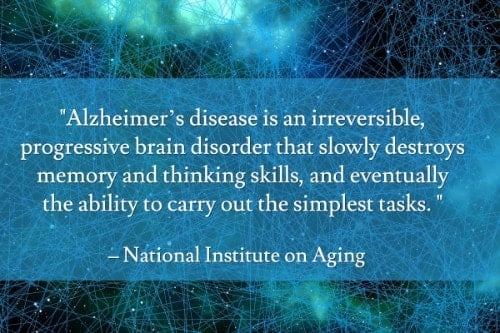
- For most people with Alzheimer’s disease, the symptoms become apparent in their mid-sixties. “Alzheimer’s disease is an irreversible, progressive brain disorder that slowly destroys memory and thinking skills, and eventually the ability to carry out the simplest tasks. In most people with Alzheimer’s, symptoms first appear in their mid-60s. Estimates vary, but experts suggest that more than 5 million Americans may have Alzheimer’s.” – Alzheimer’s Disease Fact Sheet, National Institute on Aging; Twitter: @Alzheimers_NIH
- In early-onset Alzheimer’s disease, symptoms may begin to appear in people as young as age 30. “We may think of Alzheimer’s as a disease of the elderly, but up to 5% of Americans with Alzheimer’s (around 200,000) have the early-onset variety, which can start to show symptoms as early as one’s 30’s. Though the cause still isn’t well understood, some of these cases have a genetic component.” – Top 10 Facts About Alzheimer’s Disease, Renaissance Assisted Living of Richfield/Bath
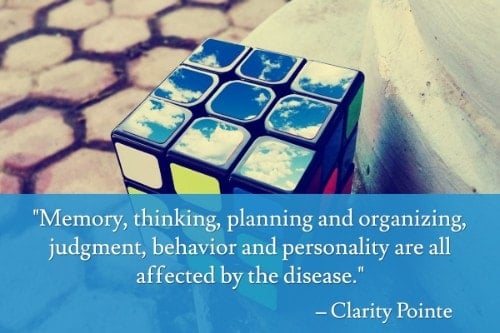
- Alzheimer’s disease isn’t just memory loss. “Alzheimer’s disease is not just memory loss. Although decreased memory is a major symptom of the disease, Alzheimer’s is actually caused by the decay of brain cells that affect different kinds of cognitive functions. Memory, thinking, planning, organizing, judgment, behavior and personality are all affected by the disease.” – 10 Facts About Alzheimer’s Disease for World Alzheimer’s Month, Clarity Pointe™
- Alzheimer’s disease is a progressive disease. “Alzheimer’s is a slow and gradual disease that progresses as the symptoms of the disease begin to worsen. The disorder usually happens over years and is not sudden. The most common symptom associated with Alzheimer’s is memory loss. In the early stages, memory loss is mild and barely noticeable. Most people do not even take it as a sign of Alzheimer’s and shrug it off as forgetfulness. However, as this symptom progresses, patients begin to forget words and are unable to carry out a conversation. They may jump between topics as they forget what they were talking about, and in most cases, struggle to find the right words to use.” – Facts About Alzheimer’s Disease, FindaTopDoc.com; Twitter: @findatopdoc
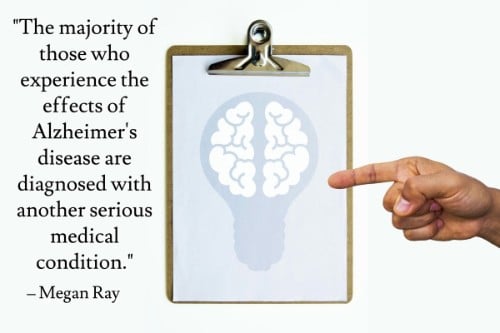
- People with Alzheimer’s disease almost always have another chronic health condition. “The majority of those who experience the effects of Alzheimer’s disease are diagnosed with another serious medical condition. According to U.S. News and World Report, approximately 60 percent of Alzheimer’s patients also have high blood pressure, 26 percent have coronary heart disease, 23 percent have diabetes and 18 percent experience osteoporosis.” Healthline explained that these illness[es] may even trigger the onset of the disease.
“The presence of Alzheimer’s also makes these conditions much more challenging to manage. Diabetes, for example, requires insulin checkups and adherence to a strict diet. Memory impairment makes these responsibilities challenging and is often what results in the initial need for a caregiver.” – Megan Ray, 5 Surprising Facts About Alzheimer’s, Sunrise Senior Living; Twitter: @SunriseSrLiving
- A diagnosis of Alzheimer’s disease doesn’t mean your life is over. “If you have been diagnosed with Alzheimer’s, do not automatically assume that your life will now come to an end. You can still maintain a productive, meaningful, and enjoyable life for years to come. It’s believed that doing your part in terms of a balanced lifestyle, could help slow down the progression of this disease or at least improve select symptoms. That means, eating a healthy diet, exercising regularly, staying socially connected, and trying to manage stress levels can all improve your quality of life. There are also plenty of resources and treatments that target specific symptoms.” – Krista Hillis, Alzheimer’s Disease: Myths vs. Facts, BrainTest®; Twitter: @braintestcom
- Alzheimer’s disease changes the structure of the brain. “Alzheimer’s can cause ventricles in the brain to enlarge and can shrink other parts of the brain like the cerebral cortex. These changes can lead to difficulty in detecting movement, directing gaze toward an object, and changes in how the pupils react to light. There are ant-dementia drugs that can help with these problems, so if you or a loved one are experiencing them, see a doctor as soon as possible.” – Dan Smilloff, Interesting Facts About Alzheimer’s Disease, Primrose Retirement; Twitter: @primroseliving
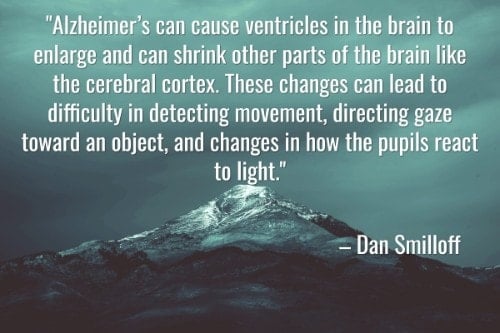
- People with advanced dementia may still have emotional memory. “A recent survey found that 42% of the public think it’s pointless to stay in contact with loved ones who have Alzheimer’s after they are unable to recognize the faces of family and friends. Alzheimer’s advocates and researchers caution against this line of thinking, saying that even as the disease progresses, people with advanced dementia can still hold an emotional memory, meaning that they remember how something made them feel long after they have forgotten they event that brought those feelings.” – Alissa Sauer, How Loved Ones with Alzheimer’s Benefit from Our Visits, Alzheimers.net; Twitter: @Alzheimersnet
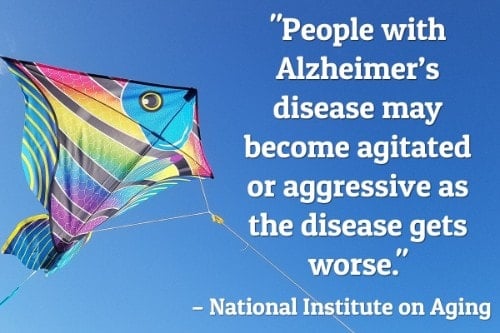
- In the later stages of the disease, people with Alzheimer’s disease may experience agitation or aggression. “People with Alzheimer’s disease may become agitated or aggressive as the disease gets worse. Agitation means that a person is restless or worried. He or she doesn’t seem to be able to settle down. Agitation may cause pacing, sleeplessness, or aggression, which is when a person lashes out verbally or tries to hit or hurt someone.” – Coping with Agitation and Aggression in Alzheimer’s Disease, National Institute on Aging; Twitter: @Alzheimers_NIH
- Wandering and sleep disturbances are also common in the later stages of Alzheimer’s disease. “As the disease progresses, an Alzheimer’s disease patient will become increasingly dependent upon his or her caregivers. You and your family must also cope with personality changes that can be disturbing. Behavioral and mood disorders, common in individuals with Alzheimer’s disease, are the most disturbing aspect of the disease for many caregivers. These disorders include depression, agitation, wandering, and sleep disturbances.” – Caring for the Alzheimer’s Disease Patient, Geriatric Mental Health Foundation; Twitter: @GeriPsyc
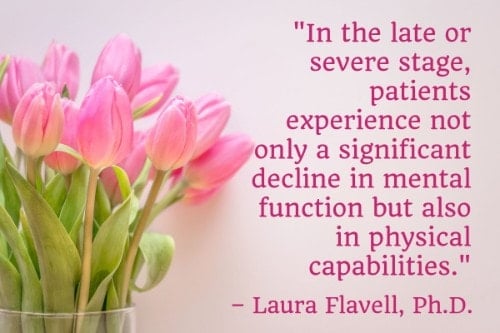
- In the late stages of Alzheimer’s disease, physical symptoms become prominent in addition to the symptoms of cognitive decline. “In the late or severe stage, patients experience not only a significant decline in mental function but also in physical capabilities. They are likely to need extensive full-time care and assistance to complete essential daily tasks such as eating, moving, dressing, and using the bathroom.” – Laura Flavell, Ph.D., Severe (Late-stage) Alzheimer’s Disease, Alzheimer’s News Today; Twitter: @adnewstoday
- Pneumonia and other infections are common causes of death among those with late-stage Alzheimer’s disease. “Pneumonia is a common cause of death because impaired swallowing allows food or beverages to enter the lungs, where an infection can begin. Other common causes of death include dehydration, malnutrition and other infections.” – Alzheimer’s stages: How the disease progresses, Mayo Clinic; Twitter: @MayoClinic
Lowering the Risk of Alzheimer’s Disease

- There are some ways to slow the progression of Alzheimer’s disease, although there is currently no cure. “While doctors can’t cure dementia yet, they’ve found ways to slow down its progress. High blood pressure and lack of exercise are risk factors for the disease, so exercise and a healthy diet can help delay it. There are also medications which have been able to extend quality of life. Mental stimulation like solving jigsaw puzzles, reading, and playing chess can also help to prevent or slow down the disease.” – 10 Facts About Alzheimer’s Disease, Watermark of Gulf Breeze
- Learning new things and keeping your mind active can help to lower the risk of developing Alzheimer’s disease. “According to the Mayo Clinic, you can greatly lower your chances of being diagnosed with Alzheimer’s if you constantly seek to learn new things in your old age. New activities, such as cooking, playing instruments and knitting can help just as much as learning new languages and enrolling in classes.” – A Few Surprising Facts About Alzheimer’s Disease, Heritage Community of Kalamazoo; Twitter: @HeritageCK
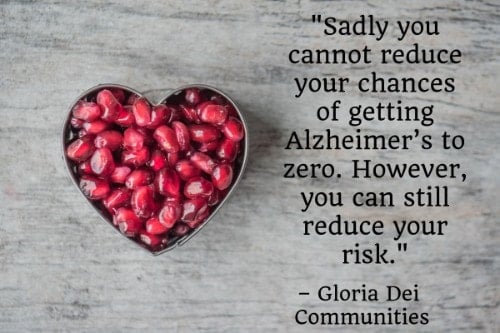
- While you can reduce some risk factors associated with Alzheimer’s disease, there is no known way to completely eliminate the risk. “Sadly you cannot reduce your chances of getting Alzheimer’s to zero. However, you can still reduce your risk. There are specific lifestyle choices you can make that will aid in the defense of your healthy brain as you age. These lifestyle choices include your diet, consumption of alcohol, smoking, and other various choices you can make that promote a healthier lifestyle.” – 7 Essential Facts About Alzheimer’s Disease, Gloria Dei Communities; Twitter: @GloriaDeiCare
- A recent clinical trial showed that aggressive treatment of high blood pressure may lower Alzheimer’s risk. “For the first time, a large, randomized clinical trial has demonstrated a significant reduction in the risk for developing cognitive decline and dementia. The new research results, announced today at the Alzheimer’s Association International Conference (AAIC), show aggressive treatment of high blood pressure (targeting a systolic blood pressure goal of less than 120 mm Hg) resulting in fewer new cases of mild cognitive impairment (slight, but noticeable and measurable decline in cognitive abilities that is not severe enough to interfere with daily life) and dementia.”
“These findings are exciting because they show — more conclusively than ever before — that there are things we can do, especially regarding cardiovascular disease risk factors, to reduce our risk of mild cognitive impairment and dementia.” – Maria C. Carrillo, Ph.D., Sprint for Discovery: New Dementia and Cardiovascular Findings, Alzheimer’s Association; Twitter: @alzassociation 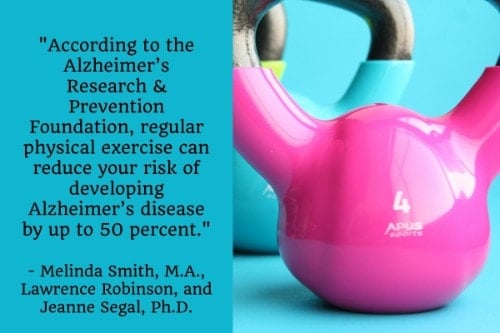
- Exercising regularly is one of the best ways to lower your risk. “According to the Alzheimer’s Research & Prevention Foundation, regular physical exercise can reduce your risk of developing Alzheimer’s disease by up to 50 percent. What’s more, exercise can also slow further deterioration in those who have already started to develop cognitive problems. Exercise protects against Alzheimer’s and other types of dementia by stimulating the brain’s ability to maintain old connections as well as make new ones.”
“Aim for at least 150 minutes of moderate intensity exercise each week. The ideal plan involves a combination of cardio exercise and strength training. Good activities for beginners include walking and swimming.” – Melinda Smith, M.A., Lawrence Robinson, and Jeanne Segal, Ph.D., Preventing Alzheimer’s Disease, HelpGuide.org
- It’s believed that untreated depression may be linked to Alzheimer’s disease, so seek treatment if you suspect that you’re suffering from depression. “While we don’t yet know how to prevent depression, we do know that many people with depression do not get adequate treatment, and that untreated depression can significantly increase risk for Alzheimer’s disease. The links between depression and dementia are complex. Many cognitive functions such as attention, memory and planning can be affected in depression (Porter et al. 2003), and in older patients, it can be unclear whether a cognitive problem is a symptom of depression, dementia, or both. It is thought that untreated depression can significantly increase risk for Alzheimer’s disease – for example the MIRAGE study found a significant association between depression and Alzheimer’s disease (Green et al. 2003).“ – 7 ways to reduce the risk of Alzheimer’s disease, Cambridge Cognition; Twitter: @CANTABconnect
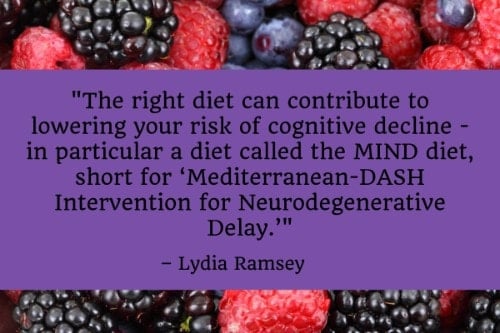
- Eating the right diet can help to lower Alzheimer’s risk. “The right diet can contribute to lowering your risk of cognitive decline – in particular a diet called the MIND diet, short for ‘Mediterranean-DASH Intervention for Neurodegenerative Delay.’ It’s a hybrid version of the Mediterranean and DASH diets, focusing on the aspects of those diets that have to do with the brain.”
“Berries, olive oil, nuts, and dark, leafy greens are staples of the diet, which was designed based on large-scale studies of cognitive decline and ranked third on US News and World Report’s annual best diet list. “A study of almost 1,000 seniors found that the diet appeared to lower the risk of Alzheimer’s by 35 percent for those who followed it moderately and by 53 percent in people who followed it closely.” – Lydia Ramsey, 6 Ways to Decrease Your Risk of Alzheimer’s Disease, Science Alert
- Obesity has been linked to Alzheimer’s disease, but losing just 5 to 10% of your body weight can help to lower your risk of chronic disease. “More than two-thirds of Americans are overweight or obese. There is clear evidence linked excess weight to Alzheimer’s, cardiovascular disease and diabetes, which are also considered risk factors for dementia. The upside is, losing just 5 to 10 percent of excess body weight can have a very positive impact on chronic disease risk. So, it’s never too early or too late to begin a weight-loss program.” – John Torres, M.D., 9 lifestyle changes, starting in childhood, may lower future Alzheimer’s risk, TODAY; Twitter: @TODAYshow
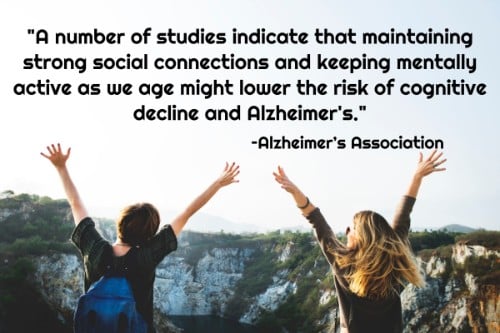
- Strong social connections may lower the risk of cognitive decline. “A number of studies indicate that maintaining strong social connections and keeping mentally active as we age might lower the risk of cognitive decline and Alzheimer’s. Experts are not certain about the reason for this association. It may be due to direct mechanisms through which social and mental stimulation strengthen connections between nerve cells in the brain.” – Prevention, Alzheimer’s Association; Twitter: @alzassociation
How Alzheimer’s Disease Impact Loved Ones
- Alzheimer’s disease is known as a “family disease” due to its impacts on loved ones. “Alzheimer’s disease is called a family disease, because the chronic stress of watching a loved one slowly decline affects everyone. An effective treatment will address the needs of the entire family. Caregivers must focus on their own needs, take time for their own health, and get support and respite from caregiving regularly to be able to sustain their well-being during this caregiving journey. Emotional and practical support, counseling, resource information, and educational programs about Alzheimer’s disease all help a caregiver provide the best possible care for a loved one.” – Alzheimer’s Disease and Caregiving, Family Caregiver Alliance; Twitter: @CaregiverAlly
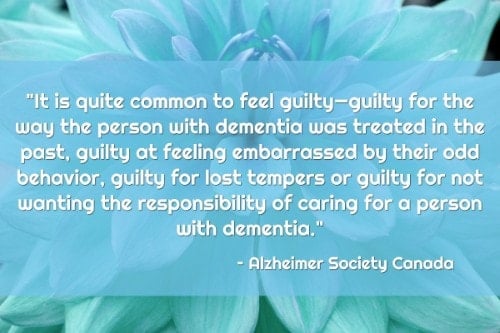
- Loved ones often have feelings of guilt. “It is quite common to feel guilty—guilty for the way the person with dementia was treated in the past, guilty at feeling embarrassed by their odd behavior, guilty for lost tempers or guilty for not wanting the responsibility of caring for a person with dementia.”
“If the person with dementia goes into hospital or residential care you may feel guilty that you have not kept him at home for longer, even though everything that could be done has been done. It is common to feel guilty about past promises such as ‘I’ll always look after you,’ when this cannot be met.” – Impact on family and friends, Alzheimer Society Canada; Twitter: @AlzCanada
- Spouses may find themselves taking on a new role in the relationship. “You may find yourself taking on a new role in your relationship as your partner’s memory declines. The person with Alzheimer’s disease may no longer be able to perform certain tasks, such as balancing the checkbook, doing the taxes, handling financial and legal matters and doing certain household chores. Making important decisions on your own may feel overwhelming.”
“Be prepared for these changes. Locate financial and legal documents, such as life insurance policies, property deeds and retirement accounts, soon after your loved one is diagnosed. Turn to family, friends, professionals or community resources for assistance, as needed.” – Changes to Your Relationship, Alzheimer’s Association; Twitter: @alzassociation 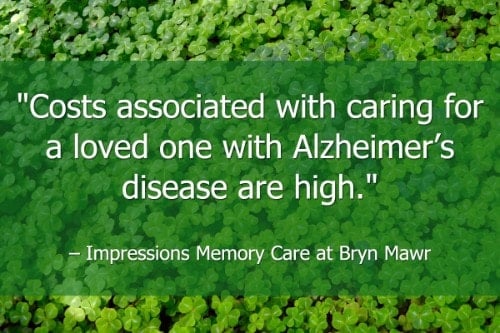
- Loved ones often face a financial burden, as well. “Costs associated with caring for a loved one with Alzheimer’s disease are high. Direct costs include physician care, diagnostic tests, pharmaceuticals and personal nursing care. Indirect costs include loss of earnings by family caregivers as they relinquish or reduce employment and paid hours out of either choice or necessity.” – The “Invisible Patients:” Alzheimer’s and Its Effects on the Family, Impressions Memory Care at Bryn Mawr; Twitter: @ImpressionsBMT
- Acceptance may be the most difficult challenge after a diagnosis, but as the disease progresses, loved ones will need to take over tasks their family member can no longer keep up with. “In the beginning, it may be hard to either accept the diagnoses of a loved one with this disease, or it may be hard to pin point this and pin down a medical diagnosis. During which time, your family member may start to experience an array of symptoms, it may be really hard to accept or understand what the right or supportive measure to take is in order to give the right kind of care to your loved one.”
“A symptom and effect on the family and/or care takers might be the daily role they had in the family; whether they cooked, cleaned or managed the household finances. This role may start to become increasingly harder for the family member to perform at the rate or ability they once did. Now might be a time to consider communication between other family members or friends to take over these roles. An introduction to home care options and care givers in the community may relieve some stress from these tasks and who to delegate them to. It’s not uncommon for those who need in home care to feel that they do not; some may truly be reluctant to let this sense of freedom go.” – Katie Kyle, The Effects of Alzheimer’s on Family and Their Care Givers, Caregivers.com 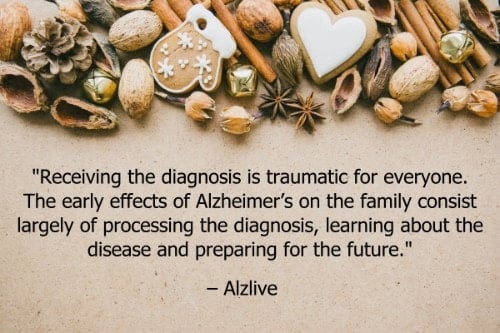
- It’s often difficult for loved ones not to internalize behaviors that are symptoms of the disease. “Receiving the diagnosis is traumatic for everyone. The early effects of Alzheimer’s on the family consist largely of processing the diagnosis, learning about the disease and preparing for the future.”
“Individuals with AD may begin to say things and act in ways that are offensive and hurtful towards others. A gentle woman may become violent or a careful man become reckless, and as the Family Caregiver Alliance, caregiver.org, points out, family members need to learn ‘to differentiate between the disease and your loved one’ in order to keep from internalizing these actions as purposefully inflicted wounds.” – Why Alzheimer’s is Called ‘The Family Disease,’ Alzlive; Twitter: @alz_live
- Depending on their age, children tend to experience a range of emotions following a grandparent’s or another loved one’s diagnosis. “Younger children may be afraid that they will get the disease or that they did something to cause it. Teenagers may become resentful when they have to take on more responsibilities around the home, or they may feel embarrassed that their parent or grandparent is ‘different.’ College-bound children may be reluctant to leave home to attend school, or may create occasions to be angry to make it easier to separate and gain independence.” – Helping Family and Friends, Alzheimer’s Association; Twitter: @alzassociation
Facts about Alzheimer’s Caregiving
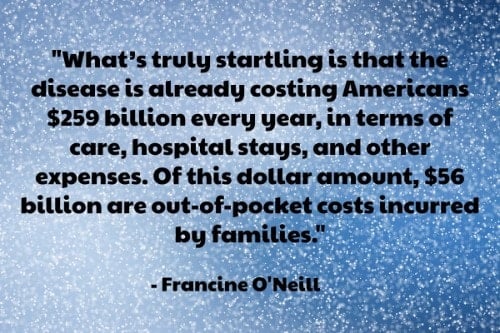
- The cost of Alzheimer’s disease is staggering, and a large portion of those costs are out-of-pocket costs incurred by families. “Alzheimer’s disease and other dementias cost the U.S. $259 billion; by 2050, that number will top $1 trillion. The quadruple increase in costs by 2050 isn’t so surprising, considering the expected increase of Alzheimer’s patients and the inevitability that healthcare costs will continue rising. What’s truly startling is that the disease is already costing Americans $259 billion every year, in terms of care, hospital stays, and other expenses. Of this dollar amount, $56 billion are out-of-pocket costs incurred by families.” – Francine O’Neill, Startling Facts About Alzheimer’s Disease in 2017, The Arbor Company; Twitter: @ArborCompany
- Caregiver stress is common among Alzheimer’s caregivers. “Levels of psychological distress are significantly higher in dementia caregivers than in other types of caregivers and non-caregivers. Caregiver stress can result in serious psychological problems, including depression and anxiety that should be treated immediately.” – The Effects of Alzheimer’s on the Family: Why it’s Important to Understand and Prepare, Saunders House; Twitter: @Saunders_House
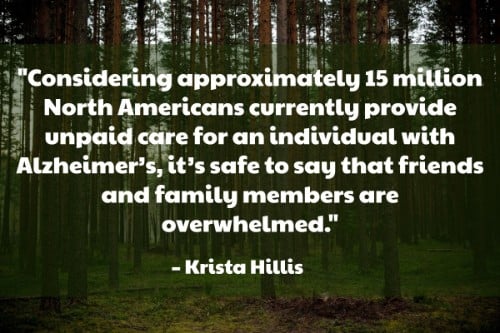
- Eighty percent (80%) of the 15 million unpaid caregivers providing care for someone with Alzheimer’s disease in North America are family members. “Considering approximately 15 million North Americans currently provide unpaid care for an individual with Alzheimer’s, it’s safe to say that friends and family members are overwhelmed. Although some of these individuals are friends and even healthcare personnel, 80 percent are family. This is resulting in caregiver burnout and the diminishing health of those involved.” – Krista Hillis, Impact of Alzheimer’s on Family and Friends, BrainTest; Twitter: @braintestcom
- The typical family caregiver is a woman in her 50s or older. “The typical family caregiver is a 50+ year-old woman caring for her widowed mother who does not live with her. She is married and employed.” – Kathleen Allen, LCSW, C-ASWCM, Alzheimer‘s Disease and Women Caregivers: The Impact and the Burden, BrightFocus Foundation; Twitter: @_BrightFocus
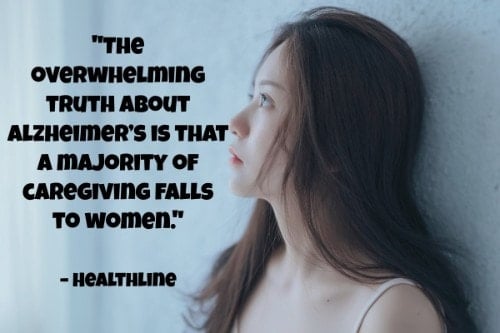
- Most often, a caregiver is the spouse or adult child of the person with Alzheimer’s disease. “The overwhelming truth about Alzheimer’s is that a majority of caregiving falls to women. Whether they see it as a privilege, a burden, or a necessity, two-thirds of the primary unpaid caregivers of those with Alzheimer’s are female. More than one-third of these women are the daughters of those they care for. Among millennials, female grandchildren are more likely to assume the role of caregiver. In general, caregivers are spouses and the adult children of those they care for more than any other relation.” – The State of Caregiving for Alzheimer’s and Related Dementia 2018, Healthline; Twitter: @Healthline
- Alzheimer’s disease has a significant effect on the daily life of a family caregiver. “For the primary caregiver, Alzheimer’s disease may have as great an impact on their daily life as it does on the loved one they care for. The role of caregiver not only affects how the person spends their time, but also their overall health and well-being. Full-time caregivers often suffer from stress, depression, high-blood pressure and other physical ailments brought on by the exertion and exhaustion of providing constant care unless they take good care of their own mental and physical health.”
“Whether the primary caregiver is the spouse or adult child of their loved one with Alzheimer’s, the alterations that caregiving causes in the relationship can take their emotional toll. A spouse may struggle with the loss of intimacy brought on by the disease and a child may face the challenges of caring for someone who used to be their greatest source of support. While Alzheimer’s disease alters these close relationships, it’s important for caregivers to find help and support to take care of their own needs as well as their loved one’s.” – Alzheimer’s Effects on the Family: Coping with Difficult Emotions, Tuscan Gardens; Twitter: @TGVenetiaBay 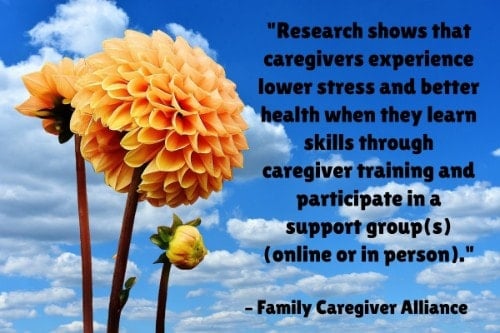
- Research shows that caregivers who participate in caregiver training may have less stress. “Through training, caregivers can learn how to manage challenging behaviors, improve communication skills, and keep the person with Alzheimer’s safe. Research shows that caregivers experience lower stress and better health when they learn skills through caregiver training and participate in a support group(s) (online or in person). Participation in these groups can allow caregivers to care for their loved one at home longer.” – Alzheimer’s Disease and Caregiving, Family Caregiver Alliance; Twitter: @CaregiverAlly
- The strain on Alzheimer’s caregivers can last for years. “Given the long duration of this disease, the strain on Alzheimer’s caregivers can last several years and produce serious declines in caregiver physical, emotional and financial well-being. In 2017, 16 million Americans provided an estimated 18.4 billion hours of unpaid care in the form of physical, emotional and financial support – a contribution to the nation valued at $232.1 billion. The difficulties associated with providing this level of care are estimated to have resulted in $11.4 billion in additional healthcare costs for Alzheimer’s and other dementia caregivers in 2017.” – 2018 Alzheimer’s Disease Facts & Figures Report, Alzheimer’s Carer Resource Center; Twitter: @AlzCareResource
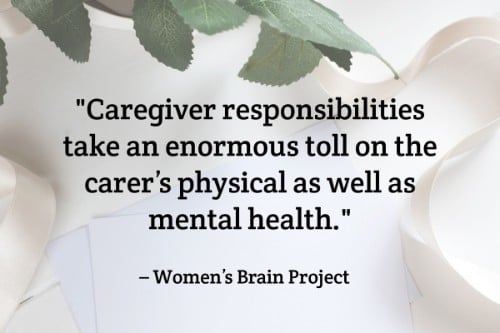
- Female Alzheimer’s caregivers are more likely to experience stress and stress-related disorders compared to male caregivers. “Caregiver responsibilities take an enormous toll on the carer’s physical as well as mental health. Informal caregivers also experience involving mental and emotional stress related to their role as caregiver. This stress increases risk for various mental health disorders and stress-related diseases. Compared to men, it has been observed that female caregivers experience greater stress and stress-related disorders including anxiety and depression as well as physical ailments (Edwards et al., 2016). In particular, research shows that women caring for a relative with Alzheimer’s disease experience worse caregiving-related stress than men (Alzheimer’s Disease Facts and Figures, Alzheimer’s & Dementia 2016).” – Facts, Women’s Brain Project; Twitter: @womensbrainpro
- Many caregivers assist loved ones with medication and other treatments, in addition to household and personal care tasks. “In addition to taking on household chores, shopping, transportation, and personal care, 37% of caregivers are involved in giving medications, injections, and medical treatments to the person they are providing care to. Of these caregivers, 77% report needing to ask for advice about the medications and medical treatments, and the person they usually turn to is their healthcare provider. While caregivers may talk to the healthcare provider about their loved one’s health, they often don’t talk about their own. Caregivers are a population at increased risk of illness and death, yet these health risks are often ignored.”
“Research indicates that family caregivers face unavoidable stresses and burdens. Caregiving may be an occupational hazard, and its demands place caregivers at risk for psychological and physical problems.” – Caregiver Health, HealthinAging.org; Twitter: @HealthInAging
More insights like this:
-
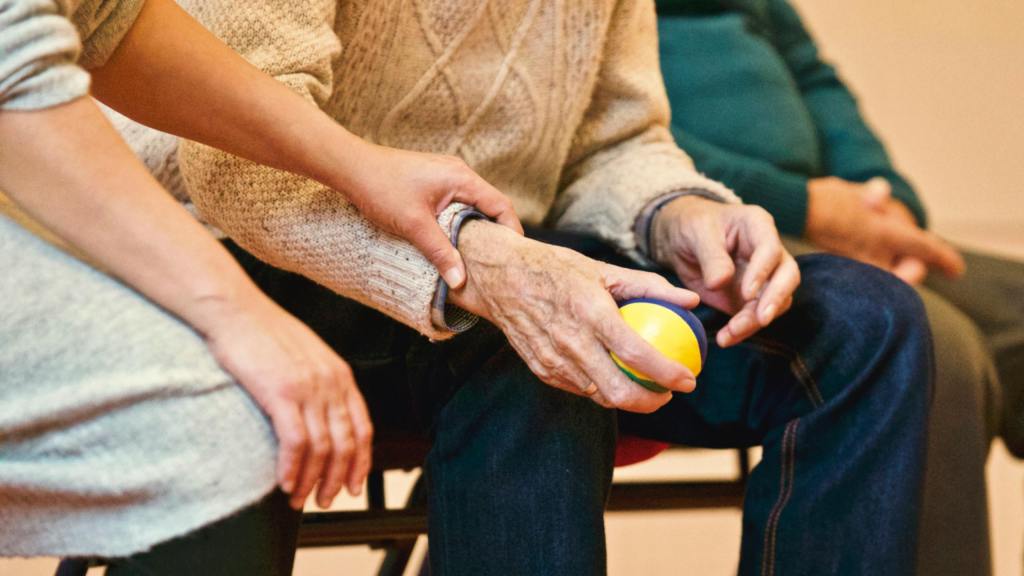
Delirium vs. Dementia: Causes, Symptoms, Treatments, and Preventative Measures
Read more: Delirium vs. Dementia: Causes, Symptoms, Treatments, and Preventative Measures5 Key Things Family Caregivers Need to Know About Delirium and Dementia Onset and Course Are Key Clues That Caregivers Should Watch Closely Delirium develops suddenly (hours or days) and often fluctuates; dementia progresses gradually over months or years. Acute changes in thinking or attention should trigger urgent medical evaluation. Delirium and Dementia…
-

What Caregivers Should Know About Early-Onset Alzheimer’s
Read more: What Caregivers Should Know About Early-Onset Alzheimer’sSymptoms, Stigma, Diagnosis, and Treatment Early-onset Alzheimer’s disease, also known as younger-onset, is the development of Alzheimer’s symptoms between the ages of 30 and 65. A diagnosis is relatively rare at a younger age, and while over 6 million people in the United States are living with Alzheimer’s disease, the true prevalence of early-onset is uncertain.…
-

15 Tips on Transitioning a Loved One to Memory, Dementia, or Alzheimer’s Care
Read more: 15 Tips on Transitioning a Loved One to Memory, Dementia, or Alzheimer’s CareAs a part of your journey caring for someone with Alzheimer’s or another form of dementia, there may come a time when the effects of the disease become too much for a caregiver to handle, and one must seek alternative care options. When deciding the right time to transition your loved one to…